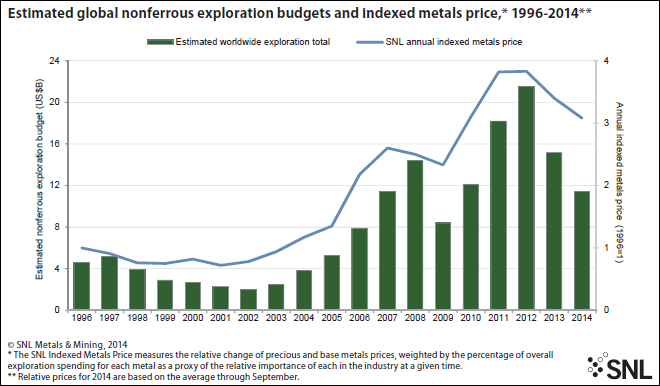According to data compiled for the forthcoming 25th edition of SNL Metals & Mining's "Corporate Exploration Strategies" study, the estimated worldwide total budget for nonferrous metals exploration dropped to US$11.36 billion in 2014 from US$15.19 billion in 2013 — a 25% decrease
.
SNL Metals & Mining's 2014 exploration data and analysis are based on information collected from almost 3,500 mining and exploration companies worldwide, of which almost 2,000 had exploration budgets for 2014. The companies, each budgeting at least US$100,000, budgeted a total of US$10.74 billion for nonferrous exploration in 2014. Including our estimates for budgets we could not obtain, the 2014 worldwide exploration budget comes to US$11.36 billion. Nonferrous exploration refers to expenditures related to precious and base metals, diamonds, uranium and some industrial minerals; it specifically excludes iron ore, aluminum, coal, and oil and gas.
Higher operating and capital costs, lower ore grades, uncertain demand for commodities and investor discontent have required major companies to focus on a return to healthy margins after years of growth-oriented spending. To that end, the majors have been divesting noncore assets and cutting back on capital project and exploration spending, which has led to an unsurprising 25% drop in the majors' exploration budget total in 2014. The juniors continue to battle lackluster investor interest, which has forced the group to rein in spending in order to conserve funds. The juniors' total exploration budget fell 29% year over year in 2014 after falling 39% in 2013, dropping their share of the overall budget total to 32% from a high of 55% in 2007.

Exploration allocations for all targets except platinum group metals decreased in 2014. Although gold remains the most attractive target, gold budgets declined for the second consecutive year — dropping 31% to US$4.57 billion — to account for the metal's lowest share of worldwide exploration budgets since 2009 at just 43%. Despite base metals budgets falling by US$1 billion, their collective share of total budgets increased 2% to reach the highest level since 2008. Base metals and gold allocations have a consistently inverse relationship in terms of their shares of overall budgets.
Despite lower allocations for most countries, companies continue to explore across the globe; exploration is planned for 124 countries in 2014, down from 127 in 2013. The share of budgets allocated to mature mining regions such as Canada and the United States fell in 2014; Canada's total budget was down 22% year on year due to weakness in the country's junior sector, while the United States' total declined 27% as many major copper producers scaled back exploration programs. Canada and Australia remained the top countries overall, with the United States, Mexico, and Chile rounding out the top five. Although Latin America's 26% year-over-year decline is relatively on par with the overall decrease in exploration budgets in 2014, two of the top exploration destinations within the region, Argentina and Colombia, saw declines of 46% and 42% respectively due to local opposition to mining and political instability. West Africa declined more than the African region — 38% compared with 28% — due primarily to the faltering gold price and regional insecurity; the Ebola crisis will almost certainly result in even further cutbacks to West Africa exploration programs in the second half of 2014.
For the first time since SNL Metals & Mining began the series of "Corporate Exploration Strategies" studies, the proportion of overall exploration budgets dedicated to mine site work surpassed the budget for grassroots activity. Since 2012, producers have been increasingly emphasizing brownfields programs as a less capital-intensive and less risky means of replacing and adding reserves. The proportion of the annual total allocated to grassroots exploration hit a record low this year, as many junior companies, which have historically accounted for the largest portion of grassroots spending, sharply curtailed programs to conserve cash as the exploration sector struggles to rebound from a two-year downward trend. This reduced focus on early stage and generative work has led to concern that many companies, and perhaps the industry in general, are sacrificing long-term project pipelines in favor of consolidation and maximizing returns.